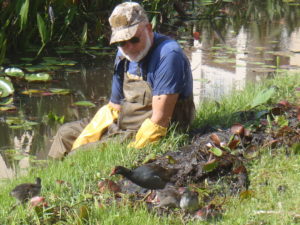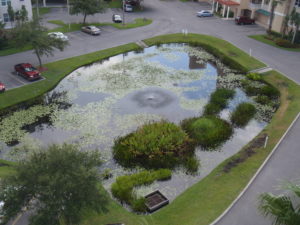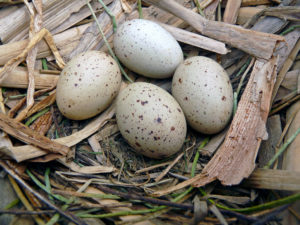
By Ernie Franke,
Chairman of Wetlands Committee of The Shores of Long Bayou
What is it about moorhens that makes them so interesting to watch? It isn’t their majestic shape, because they resemble black barnyard chickens with vivid red frontal crests and yellow beaks, much like candy corn seen at Halloween. It isn’t the way they walk, because they resemble a pigeon, doing the “funky chicken” motion as they swim or walk. It isn’t the way they swim like a duck, because they don’t have web feet. It’s not how they fly, because they only clumsily fly for short distances, with ungainly legs dangling from their bodies.
They go by several different names such as common gallinule, Florida gallinule, swamp chicken and waterhen. Folks often call them coots, but coots differ as the version with the white shield on its forehead. The common moorhen is more closely related to cranes and rails than to ducks or chickens, even though they swim like ducks and peck for seeds like chickens.

The most widely distributed member of the rail family, the common moorhen inhabits marshes and ponds from Canada to Chile, from northern Europe to southern Africa, and across Asia to the Pacific. Twelve subspecies are recognized around the world, most differing only in size or brightness of plumage. Vocal and boldly marked, the species can be quite conspicuous, appearing to walk on water as it uses its long toes to walk atop floating vegetation.
Just watching the mating rituals, the babies, the protective actions of the parents, and the feeding of the babies makes them a great addition to an urban stormwater retention pond. They provide endless hours of amusement because they are not migratory in Florida. Their loud signature “kurr’uk” call to announce their presence or warn others if a predator approaches sounds like someone is torturing a frog. It’s often impossible to tell what might spook them. Sometimes just seeing their reflection will set one off, while the other moorhens just stare at the water.
Providing a Habitat in an Urban Environment

As wildlife habitats shrink with urban development, we must provide alternate freshwater habitats for waterfowl. The common moorhen is an abundant bird with a global population that likely numbers several million birds, but is currently endangered due to habitat destruction in some parts of the country. In other places, man-made modifications like reservoirs and artificial wetlands have actually increased the amount of habitat available to the common moorhen.

In the coastal regions of Florida, development has led to lakes and ponds that serve as retention areas for stormwater run-off control (Learn more about Franke’s long-term commitment to improving water quality).
By planting native plants, we were able to duplicate their nesting habitat within the urban setting by forming small breeder islands within several stormwater retention ponds. The advantage of forming these islands is isolation. The moorhen loves to have the security of an island it can call its own. Condo dwellers love to keep track of their moorhens. Water forms a barrier for both raccoons and people. Everyone wins.
A wide bowl of grasses and sedges, usually taken from near the nest site and anchored to emergent vegetation, provides the nest for the common moorhen. They build nests of aquatic vegetation, but above water level closer to shoreline with a ramp leading to the water. Typically, five to nine eggs are produced, while incubation takes about three weeks.
For a day or so, the newly hatched chicks are fed on the nest with a parent brooding them (keeping them warm) most of the time. The rail family (moorhens, coots, etc.) feed their young rather than just leading them to where food is as a duck would do. But the chicks soon venture out onto the water. The summer air is full of the ‘peeps’ of hungry chicks.
Moorhen chicks have black, downy feathers except around the eye and bill. Usually two or three hatch first, and go off with one adult, while the rest follow and stick with the other parent. They can swim soon after hatching and spend most of the time swimming with their parents, staying close to vegetation for protection. The chicks grow rapidly. Once all the chicks leave the nest, the moorhens use the nest for sleeping at night. The mated pair may raise more than one brood in a season, using the same nest. The chicks fledge (leave the nest) after two months and raise their own first brood the following spring. The fledglings stay with the family for the remainder of the year.
 “Aunt” Moves from Noun to Verb
“Aunt” Moves from Noun to Verb
Growing by the day, these youngsters stride determinedly after mum or dad in the never-ending search for food. As the chicks get bigger they want more and bigger items of food. The parents are worn to a frazzle from first light to well past sunset, bringing them seeds and insects. The parents may raise more than one brood in a season, using the same nest after making some repairs. If there is an early spring, you might see three broods: early March, June and late August.
An unusual habit of moorhens is that chicks from the first brood often stay around in their natal territory and help feed their siblings from the second (or third) brood. Older juveniles from an earlier brood help the parents raise the new chicks. Moorhens are one of the few birds that exhibit this “aunting” process, permitting another moorhen to act as a parent, where the juveniles help feed and attend to the latest brood. If the parents produce a third brood, they can relax even more, with both the “adolescents” and “teenagers” helping to feed the latest fluffballs.
Helpers can make a difference in the number of surviving chicks for subsequent broods. Second and subsequent broods are often fed and guarded by adolescent members of earlier broods that remain near the nesting site. They are not as good at it as their parents, and may offer items like corn grains by mistake. The chicks just know to refuse them and eventually get offered something suitable. Juvenile moorhens are brownish with paler throat and belly, a dull, whitish-buff stripe on their flanks, and dusky bill and legs. As the moorhen matures over a six-month period, the gray coat turns black and the beak turns from black to orange.
Moorhens who performed as aunts make better parents and are more protective of their own first brood. By the middle of winter, the resident pair will see them off as they develop the red and yellow beaks and black plumage of the adults and leave to find their own nesting site for the following spring.
Moorhen habitat and prior restorations at The Shores of Long Bayou were funded with a Bay Mini-Grant from the Tampa Bay Estuary Program.

